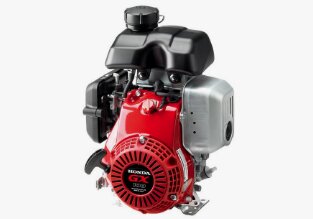____________________________________________________________________________________
| Home / Small Engines / Honda Engines / Honda GX100 |
Honda GX100 Troubleshooting
| Engine Model: Honda GX100 |
| Engine Type: 4-cycle 1-cylinder air-cooled gasoline engine |
| Total Displacement: 6.0 cu.in (98 cc) |
| Rated Engine Power: 3.0 Hp (2.3 kW) at 4000 rpm |
| Carburetor Type: Horizonal, butterfly valve |

____________________________________________________________________________________
| Engine hard starting or not starting |
Empty gas tank - Fill fuel up.
Low-quality gasoline - Use correct gasoline grade.
Dirty fuel lines - Inspect and clean.
Spark plug wiring connection is defective - Inspect the spark plug wire connection, replace or repair.
Spark plug is faulty - Change spark plug.
Dirty fuel filter - Install new filter.
Brake pedal not depressed - Press the brake pedal.
Carburetor is dirty - Wash, clean and adjust.
Engine has low compression - Check cylinder block and replace defective parts.
Choke cable is not adjusted properly or worn - Replace cable or adjust correctly.
| Engine runs roughly |
Air intake grill is clogged - Need to wash or clean.
Ignition system malfunction - Test ignition and replace failed parts.
Choke cable is stuck or faulty - Change or service the cable.
Air filter element is plugged - Change or clean air filter.
Fuel pump is defective or dirty - Clean or replace fuel pump.
| Engine starts but then shuts off |
Faulty spark plug - Change spark plug.
Clogged or defective carburetor - Service or change carburetor.
Ignition coil is defective - Change ignition coil as required.
Bad or damaged valve springs - Change valve springs.
Valves are stuck - Service the valves.
| Engine overheated |
Engine oil insufficient - Add oil to the engine crankcase.
Engine is under excessive load - Load reducing required.
Cooling fins are clogged - Clean and wash as required.
Too lean fuel mixture in carburetor - Set the carburetor properly.
Ignition timing is improper - Adjust ignition timing as required.
Improper valve setting - Adjust valves as required.
| Engine knocking sound or abnormal noise |
Stale gasoline - Change fuel.
Engine overloaded - Reduce load.
Insufficient engine oil - Add oil to the engine crankcase.
Wrong adjustment of low idle speed - Test and adjust.
Clogged or damaged fuel pump - Check fuel pump and change if required.
Crankshaft or main bearings are worn out - Replace crankshaft or bearings.
Excessive valve clearance - Check and adjust.
Piston rings or cylinder bore are damaged - Change defective parts.
| Loss of engine power |
Incorrectly adjusted or dirty carburetor - Adjust carburetor properly or service it.
Plugged air filter - Clean or replace air filter.
Fuel pump is faulty or clogged - Inspect fuel pump and change as required.
Defective ignition - Test ignition and replace failed parts.
Cylinder head gasket is blown - Replace cylinder head gasket.
Valves are stuck or burned - Change or service valves.
Worn or defective push rod - Replace push rod.
Damaged cylinder block parts - Replace defective components as required.
Plugged oil filter (if equipped) - Replace or service oil filter.
| Engine using too much gasoline |
Throttle not fully open - Check throttle cable and adjust as required.
Carburetor main jet adjustment is improper - Adjust the carburetor main jet properly.
Loose or faulty spark plug - Spark plug need to be replaced or tightened.
Valves are worn, stuck, or burned - Change or service valves.
Worn rings, piston, or sleeve - Change faulty components.
Valve clearance is wrong - Adjust valve clearance according to specifications.
| Engine consuming too much oil |
Damaged gaskets or seals - Change worn parts according to specifications.
Worn valve stems and valve guides - Valves must be replaced.
Piston rings are stuck or worn - Have piston rings replaced.
Piston or cylinder liner is scuffed - Inspect piston and liner, change as required.
Clogged breather hose or pipe - Change or clean.
____________________________________________________________________________________

